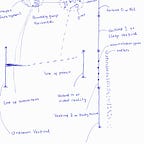LLMs: Attributions of Consciousness, Sentience to Generative AI Chatbots
There is a new feature in MIT Technology Review, Minds of machines: The great AI consciousness conundrum, where, in reference to chocolate and consciousness, it was expressed that, “Placing a piece in your mouth sparks a symphony of neurobiological events — your tongue’s sugar and fat receptors activate brain-bound pathways, clusters of cells in the brain stem stimulate your salivary glands, and neurons deep within your head release the chemical dopamine. None of those processes, though, captures what it is like to snap a chocolate square from its foil packet and let it melt in your mouth.”
There is a recent paper in Trends in Cognitive Sciences, Consciousness in the cradle: on the emergence of infant experience, concluding that, “Although progress in understanding the origins of consciousness will likely be advanced by a better understanding of brain development, understanding the implications of developmental data for accounts of the emergence of consciousness will also require a better understanding of the neural and functional basis of consciousness.”
There is an upcoming event, Attributions of Consciousness to AI, to discuss “current understanding and potential measures of consciousness in AI, as well as determinants and consequences of lay attributions of consciousness to non-biological agents.”
If someone is ill and loses the sense of taste, if the person puts a chocolate on the tongue, but unable to get the taste of it, would the consciousness of the chocolate in that moment not just be knowing that it is a chocolate by seeing it, reading the label, or touching to feel it?
Since seeing color is said to be subjective, or touching something. If something is seen and read, is that not also subjective? Reading is not just about seeing, but knowing from what was learned. Consciousness of reading though similar to others, is a slice that generative AI may have imitated, without the subjective angle.
What does consciousness do when it is present? How does the presence of consciousness give a stratified range [of knowing and experiences] when available? What does it mean to see the sky and different shapes or symbols in the cloud? If someone is in a mildly lit room, and sees something but uncertain of what, then light is given and becomes clear, what is the difference between seeing and not knowing, then seeing and knowing — with better lighting?
Infants may sometimes reject food, or stop ingestion after a while. Infants may sometimes react to excessive light or sounds, they hear, smell, taste, feel and hear. These senses may not be as complex as in adults, but there is a parallel.
In brain science, it is known that the brain interprets sensory inputs. A way to translate interpretations is purses or shapes where incoming sensory signals fit into, such that what is known or experienced is submitted by the shape that absorbs the signal.
This shape applies to internal and external senses. This shape or interpretation is proposed to drive biological consciousness. Simply, what become of sensory inputs in the brain are the envelopes or purses to which they fit. Experiences are structured by these purses.
Whenever something is seen and not known, it means that it did not fit in a purse. When something is forgotten, it means that the distribution from one purse went to the purse that was remembered, skipping the one that was forgotten.
It is theorized that electrical and chemical impulses of brain cells set the formations that collect incoming signals. Simply, each purse is a combination of chemical impulses — in a set or loop. This means that different chemical impulses contribute, resulting in knowing and experiential outcomes. It is this combination of different chemical impulses that shape memory, emotions, feelings, thoughts, modulations and so forth.
Concentration of chemical impulses in formations move from side-to-side, this density variation makes experiences subjective, or present the sense of self. Simply, purses or envelopes have changing concentrations from one area to the next, this diffusion results in the self.
In the formations for chemical impulses, there are some spaces with certain diameters — nearly constant — across changing densities. There are access to some of these spaces, becoming sources for control, free will or intentionality.
Humans have more of these purses [or formation] than other organisms. Since the purses present interpretation, sentience or consciousness can be defined as the rate of interpretation, or knowing. Adult humans have a total, estimated as 1. Infants have a lesser total, but can be calculated, since their senses are interpreted similarly to humans, even if they do not have extensive subjective experiences.
Generative AI’s can also be calculated, where they have imitations that match with humans, especially on memory.
Generative AI does not have subjective experience. However, it has quasi-purses, like biological consciousness in humans. These, mostly in the memory division, have their rates. Fears about relational changes with AI, if conscious, should maybe be limited, since AI may not have subjective experience comparable to humans. It seems to know and will know more [by output]. But experiencing the taste of a chocolate and other stuff may elude it.
